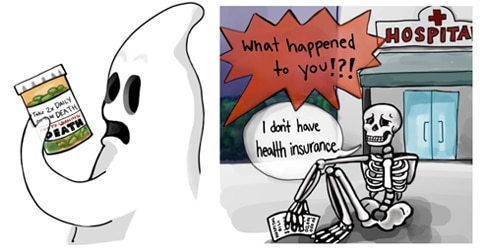

The word malnutrition is most often used to describe diets deficient in calories or essential nutrients. Chances are high that you have heard it used in that context, associated with starvation and extreme poverty.
But this is only one side of malnutrition. Taking its definition literally (the prefix mal– meaning “poor” or “faulty”), malnutrition should also apply to dietary patterns of excess that produce obesity and diet-related diseases like heart disease and type II diabetes. These cases of malnutrition are on the rise: 1.9 billion adults worldwide are now overweight or obese, more than four times as many as are undernourished (462 million); this growing gap is most pronounced in high-income countries, but even the low- and middle-income countries that bear the greatest burden of undernourishment are experiencing rising rates of obesity and overweight.[1]
This article will focus on the chronic disease side of malnutrition. The damage it causes is ignored too often.
Lives Lost: The Ultimate Cost
The most obvious cost of malnutrition is death. Although not typically listed as an official cause of death, many of the top causes of death in the United States have strong ties to our unhealthy diets. Consider the Centers for Disease Control and Prevention’s (CDC) most up-to-date list of the top causes of death in the United States, rounded to the nearest thousand:[2]
- Heart disease: 647,000
- Cancer: 599,000
- Accidents: 170,000
- Chronic lower respiratory diseases: 160,000
- Stroke: 146,000
- Alzheimer’s disease: 121,000
- Diabetes: 84,000
- Influenza and pneumonia: 56,000
- Nephritis, nephritic syndrome, and nephrosis: 51,000
- Suicide: 47,000
View more facts on malnutrition in this infographic.
To some extent, malnutrition plays a role in almost all of these causes of death. For example, up to 90 percent of heart disease deaths, 70 percent of cancer deaths, and 50 percent of stroke deaths could be prevented by the informed use of nutrition.[3][4] Likewise, it is widely accepted in the medical community that most type II diabetes could be prevented by better nutrition.
If we were to adjust this list to account for only those percentages—to account for the shared cause propelling only those deaths—there would be no denying that malnutrition is the number one cause of death in our society today.
Even causes of death that seem less tied to nutrition deserve a closer look. Take, for example, accidental drug overdoses (included in the broader category of accidents) and suicides. On the face of it, these so-called “deaths of despair,” which have never been higher, have little to do with nutrition.[5][6][7] But when we consider the psychological distress caused by being unwell, confused about how to treat oneself, and unable to pay for expensive treatments (more on this in a moment) that often rely on addictive drugs and by and large fail to treat the root cause of the illness, we see that mental and physical health are tightly intertwined.[8][9] In short, none of these factors exists in a vacuum. The web of nutrition-related diseases is a messy tangle. So long as malnutrition exists, and so long as it is a major drain on our quality of life—producing numerous preventable diseases and their accompanying costs—it will also contribute to our despair and resulting deaths.
But just how severe is this drain on our quality of life? Can we begin to quantify it?

The Cost of Malnutrition to Individuals
The financial costs of managing diseases caused by malnutrition probably seem more profane than the lives lost, but these costs are significant. Take, for example, the two leading causes of death listed above: heart disease and cancer. According to a paper published in the American Journal of Managed Care (AJMC), patients with established cardiovascular disease paid nearly $19,000 annually in direct costs for medical treatment, an “economic burden… substantially greater than current American Heart Association estimates.”[10] Meanwhile, for cancer, the average cost of one round of chemotherapy ranges from $20,000 (office-managed) to $26,000 (hospital-managed).[11]
Most Americans cannot deal with these costs. Sixty-three percent of Americans cannot afford an unexpected bill of even 500 dollars.[12] A bad diagnosis is, for the vast majority, not only a threat to their lives but also a financial death sentence. For a poignant illustration of the resulting desperation, we only need to look at the flood of fundraisers asking for assistance with medical bills. On GoFundMe alone, this category of fundraisers makes up over 250,000 campaigns per year, more than twice as many as exist for education, memorial, or natural disaster emergency fundraisers.[13]
A well-publicized study published in the American Journal of Medicine, completed by researchers from Harvard and Ohio University, shows what happens to those individuals who cannot raise funds elsewhere.[14] They found that 62.1 percent of bankruptcies in 2007 could be attributed to medical expenses. One of the startling details from that study was that “most medical debtors were well educated, owned homes, and had middle-class occupations. [And] three quarters had health insurance.” Where does that leave the uninsured? Or low-income Americans who on average suffer from a higher prevalence of poor health outcomes?[15]
Regrettably, these numbers are not moving in the right direction. The proportion of bankruptcies attributed to medical bills in 2001, just six years prior, rose by nearly fifty percent![14] This makes sense given that the cost of treatment has also increased. According to data assembled by the Peterson Center on Healthcare and Kaiser Family Foundation, “on a per capita basis, health spending has increased over 31-fold in the last four decades;” inflation-adjusted per capita spending on prescription drugs has also increased.[16][17]
The Cost of Malnutrition to Society
Although not all healthcare spending can be attributed to malnutrition, trends in the cost of healthcare nevertheless illustrate the major trends, and it’s clear from those trends that we are not on the right track. Health expenditures as a percentage of GDP in the US are more than three times greater than they were sixty years ago and remain significantly higher than the healthcare spending in other high-income countries.[18][19]
The CDC’s “Health and Economic Costs of Chronic Diseases” web page illustrates the problem well.[20] Here are a few highlights cited on that webpage, from various reports that you can find listed in their references:
- Chronic conditions account for “90% of the nation’s $3.5 trillion in annual health care expenditures.”
- Heart disease and stroke cost “our health care system $199 billion per year” not including lost productivity ($131 billion)
- In 2013, more than $300 billion in cost was attributed to arthritis.
- Nearly $150 billion in cost is attributed to obesity each year.
- “$327 billion in medical costs and lost productivity” were attributed to diabetes in 2017.
- “The cost of cancer care continues to rise and is expected to reach almost $174 billion” [emphasis added]
However, the reason this webpage illustrates the problem well is not only because it catalogs the economic toll of malnutrition-related diseases and illness but also because it completely ignores nutrition. The word nutrition does not appear once on the entire page. Neither does diet. This absence is especially shocking given that the site does make mention of three other risk factors: cigarette smoking, sedentary lifestyles, and excess alcohol consumption.
The problem it illustrates, ultimately, is not only that malnutrition contributes to astronomical costs but also that so many prefer to ignore it. How will we begin to address these problems if even our trusted institutions fail to acknowledge their existence?
The Cost of Malnutrition Is a Moving Target
It’s useful to repeat the earlier questions: Just how major is this drain on our quality of life? Can we even begin to quantify it? The answer, for now, is no.
We know the cost of malnutrition is deep. We know it’s difficult to quantify. It’s always changing. In just this short piece, we have barely scratched the surface. Even still, there are plenty of challenges to wrestle with, and the first and last of them is the same: we must stop ignoring malnutrition and the damage it causes. We should call our dietary patterns of excess what they are, admit the primary cause underlying so many premature deaths in this country, and not be afraid to confront its consequences.
To ignore malnutrition is to ignore a tremendous opportunity for growth.
This article is part of a series on The Future of Nutrition: An Insider’s Look at the Science, Why We Keep Getting It Wrong, and How to Start Getting It Right by T. Colin Campbell, PhD, (with Nelson Disla) released December 2020.
References
- World Health Organization (WHO). Malnutrition fact sheet (2020). https://www.who.int/news-room/fact-sheets/detail/malnutrition.
- Centers for Disease Control and Prevention (CDC) National Center for Health Statistics (NCHS). Leading Causes of Death (2017). https://www.cdc.gov/nchs/fastats/leading-causes-of-death.htm.
- Esselstyn, C. B., Jr., Gendy, G., Doyle, J., Golubic, M., & Roizen, M. F. A way to reverse CAD? J Fam. Pract.63, 356–364b (2014).
- Doll, R. & Peto, R. The causes of cancer: quantitative estimates of avoidable risks of cancer in the United States today. J Natl Cancer Inst 66, 1191–1308 (1981).
- Case A. & Deaton A. Deaths of Despair and the Future of Capitalism. Princeton University Press. (2020).
- Centers for Disease Control and Prevention (CDC) National Center for Health Statistics (NCHS). Increase in suicide mortality in the united states, 1999–2018 (2020). https://www.cdc.gov/nchs/products/databriefs/db362.htm
- Centers for Disease Control and Prevention (CDC) National Center for Health Statistics (NCHS). NCHS data on drug-poisoning deaths (2018). https://www.cdc.gov/nchs/data/factsheets/factsheet-drug-poisoning.htm
- Goodwin, G. M. Depression and associated physical diseases and symptoms. Dialogues in clinical neuroscience 8(2), 259–265 (2006).
- National Institute on Drug Abuse (NIDA). Opioid overdose crisis (2020).
https://www.drugabuse.gov/drug-topics/opioids/opioid-overdose-crisis - Nichols G. A., Bell T. J., Pedula K. L., O’Keeffe-Rosetti M. Medical care costs among patients with established cardiovascular disease. Am J Manag Care 16(3), 86–93 (2010).
- Avalere Health LLC. Total cost of cancer care by site of service: physician office vs outpatient hospital (2012). http://www.communityoncology.org/pdfs/avalere-cost-of-cancer-care-study.pdf.
- McGrath, M. 63% of americans don’t have enough savings to cover a $500 emergency. Forbes (2016). https://www.forbes.com/sites/maggiemcgrath/2016/01/06/63-of-americans-dont-have-enough-savings-to-cover-a-500-emergency/#23320d5c4e0d.
- GoFundMe. Medical fundraising (2020). https://www.gofundme.com/start/medical-fundraising.
- Himmelstein D. U., Thorne D., Warren E., Woolhandler S. Medical bankruptcy in the united states, 2007: results of a national study. Am J Med 122(8), 741–746 (2009). DOI: 10.1016/j.amjmed.2009.04.012
- Shaw K. M., Theis K. A., Self-Brown S, Roblin D. W., Barker L. Chronic disease disparities by county economic status and metropolitan classification, behavioral risk factor surveillance system, 2013. Preventing Chronic Disease 13 (2016). DOI: http://dx.doi.org/10.5888/pcd13.160088
- Peterson-KFF. How has U.S. spending on healthcare changed over time? (2019). https://www.healthsystemtracker.org/chart-collection/u-s-spending-healthcare-changed-time/#item-start
- Peterson-KFF. What are the recent and forecasted trends in prescription drug spending? (2019). https://www.healthsystemtracker.org/chart-collection/recent-forecasted-trends-prescription-drug-spending/#item-annual-growth-in-rx-drug-spending-and-total-health-spending-per-capita_nhe-projections-2018-27
- Amadeo, K. The rising cost of health care by year and its causes. The Balance (2019). https://www.thebalance.com/causes-of-rising-healthcare-costs-4064878
- The World Bank. Current health expenditure (% of gdp) – united states (2017). https://data.worldbank.org/indicator/SH.XPD.CHEX.GD.ZS?contextual=aggregate&locations=US
- Centers for Disease Control and Prevention (CDC) National Center for Chronic Disease Prevention and Health Promotion (NCCDPHP). Health and economic costs of chronic diseases (2020). https://www.cdc.gov/chronicdisease/about/costs/index.html
Copyright 2025 Center for Nutrition Studies. All rights reserved.
Deepen Your Knowledge With Our
Plant-Based Nutrition
Certificate
Plant-Based Nutrition Certificate
- 23,000+ students
- 100% online, learn at your own pace
- No prerequisites
- Continuing education credits





